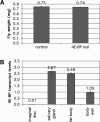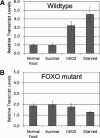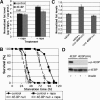4E-BP functions as a metabolic brake used under stress conditions but not during normal growth
- PMID: 16103212
- PMCID: PMC1186183
- DOI: 10.1101/gad.341505
4E-BP functions as a metabolic brake used under stress conditions but not during normal growth
Abstract
4E-BP is an important regulator of overall translation levels in cells. By binding eIF4E, 4E-BP impairs recruitment of the 40S ribosomal subunit to the cap structure present at the 5'-end of all eukaryotic cellular mRNAs. 4E-BP activity is controlled by TOR (Target of Rapamycin). 4E-BP has been studied extensively in cell culture; however, the biological role of 4E-BP in developing organisms is unclear to date. Since TOR has been shown to control tissue growth during animal development, 4E-BP has also been assumed to serve as a growth regulator. Here, we study the relevance of 4E-BP function for organismal development, and present evidence for an alternate view. We show that 4E-BP strongly affects fat metabolism in Drosophila. We suggest that 4E-BP works as a metabolic brake that is activated under conditions of environmental stress to control fat metabolism. 4E-BP mutants lack this regulation, reducing their ability to survive under unfavorable conditions.
Figures





References
-
- Arquier N., Bourouis, M., Colombani, J., and Leopold, P. 2005. Drosophila Lk6 Kinase Controls Phosphorylation of Eukaryotic translation initiation factor 4E and promotes normal growth and development. Curr. Biol. 15: 19–23. - PubMed
-
- Bernal A. Schoenfeld, R., Kleinhesselink, K., and Kimbrell, D.A. 2004. Loss of Thor, the single 4E-BP gene of Drosophila, does not result in lethality. Dros. Inf. Serv. 87: 81–84.
-
- Clancy D.J., Gems, D., Harshman, L.G., Oldham, S., Stocker, H., Hafen, E., Leevers, S.J., and Partridge, L. 2001. Extension of life-span by loss of CHICO, a Drosophila insulin receptor substrate protein. Science 292: 104–106. - PubMed
MeSH terms
Substances
LinkOut - more resources
Full Text Sources
Molecular Biology Databases
Miscellaneous
